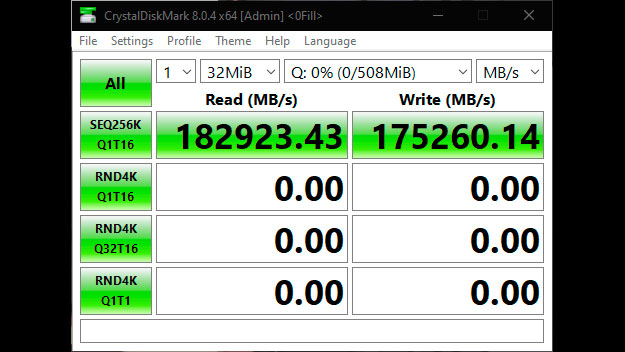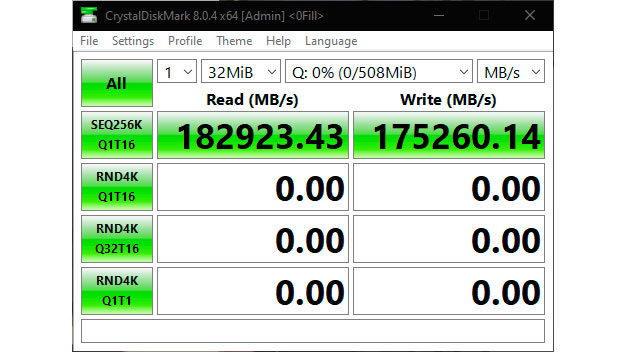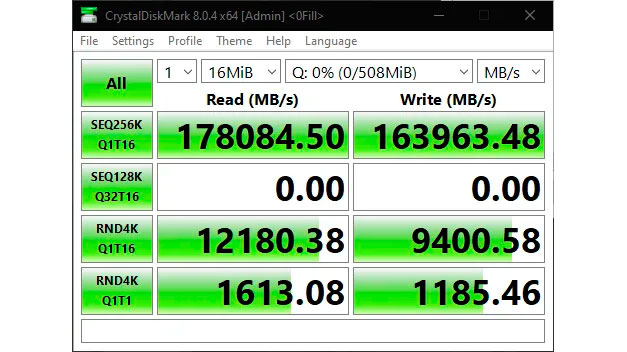
Who would have thought that the best CPUs could rival the best SSDs? Apparently, it's possible to run a RAM disk on AMD's Ryzen 3D V-Cache processors and achieve sequential read and write speeds that blow even the fastest PCIe 5.0 SSDs out of the water.
The enigma started with an intriguing screenshot shared by our cooling expert Albert Thomas, where a RAM disk delivered sequential read and write speeds around 178 GB/s and 163 GB/s, respectively, in CrystalDiskMark. What stood out was that the results were reportedly from a RAM disk running on AMD's Ryzen 7 7800X3D processor.
At first, there was some skepticism to the claim because you would need to expose the L3 as a block storage device to run the CrystalDiskMark benchmark. The supposed volume (508MB) is larger than the 3D V-Cache on the Ryzen 7 7800X3D, which has 96MB of L3 cache. However, there appears to be a legitimate method to leverage the 3D V-Cache for a RAM disk.
Nemez, a user on X (formerly Twitter), discovered the method. The enthusiast shared the steps to make it work in February, but it had passed under the radar. The results were even more remarkable than those from Thomas, with the RAM disk hitting sequential read and write speeds around 182 GB/s and 175 GB/s, respectively, on the last-generation Ryzen 7 5800X3D.


The method is based on OSFMount, free software that allows you to create RAM disks and mount the image files in different formats. Creating a RAM disk with FAT32 formatting doesn't sound like anything out of this world. However, you need to use precise settings on CrystalDiskMark to make it work. According to Nemez, you must configure the test values to SEQ 256KB, queue depth to 1, and threads to 16. You also have to set the data fill to zeros instead of random. Due to the nature of the system load, the method may not work on the first try, so you might have to run the benchmark a few times.
Seeing enthusiasts find new usage for AMD's 3D V-Cache is fascinating. While the performance figures look extraordinary, they're still far from fulfilling 3D V-Cache's potential. For instance, the first-generation 3D V-Cache has a peak throughput of 2 TB/s. AMD subsequently bumped the bandwidth up to 2.5 TB/s on the second-generation variant.
The experiment is cool but not practical in real-world usage because there's no consistent way to tap the 3D V-Cache. The method isn't infallible and sometimes requires trial and error work. Besides, the 3D V-Cache on consumer Ryzen chips is way too small to be helpful. For instance, the flagship Ryzen 9 7950X3D only has 128MB of L3 cache. On the other hand, AMD's EPYC processors, such as Genoa-X, which has 1.3GB of L3 cache, could be an interesting use case.
Nonetheless, we think there's potential with a 3D V-Cache and a RAM disk. It's a clever way of making old-school and new technologies gel together. SSDs have made RAM disks obsolete, but maybe massive slabs of 3D V-Cache can revive them. Just think of the possibilities if AMD embraced the idea and put out a fail-safe implementation where consumers can turn the 3D V-Cache into a RAM disk with a flip of a switch.








